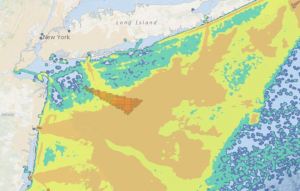November 3, 2016 — WASHINGTON– Areas off the New York coast will be open for offshore wind energy bidders, but some area is reserved because of ecological concerns, the U.S. government said.
The U.S. Interior Department, in coordination with its Bureau of Ocean Energy Management, said it would open 79,350 acres off the coast of New York up for a commercial wind energy lease sale. About 1,780 acres was removed because of environmental concerns associated with a subsea feature known as the Cholera Bank.
“In a comment letter, the National Marine Fisheries Service identified the Cholera Bank feature as a sensitive habitat to be avoided for the placement of structures,” an Interior Department stated read. “As a result of this removal, the revised lease area will be approximately two percent smaller than the lease area considered in the proposed sale notice.”
For oil and gas, the Interior Department this year revised lease plans to include 10 potential sales in the Gulf of Mexico and three for offshore Alaska. Initial considerations for lease sales in the Atlantic were removed because of “current market dynamics, strong local opposition and conflicts with competing commercial and military ocean uses,” the department said.
The U.S. Defense Department said there may be areas in the original proposal for the Atlantic that may not be compatible with defense operations and interests.
Wind energy development up and down the New England coast has been met with opposition from preservationists worried about the potential threat to coastal habitats and aesthetics.

